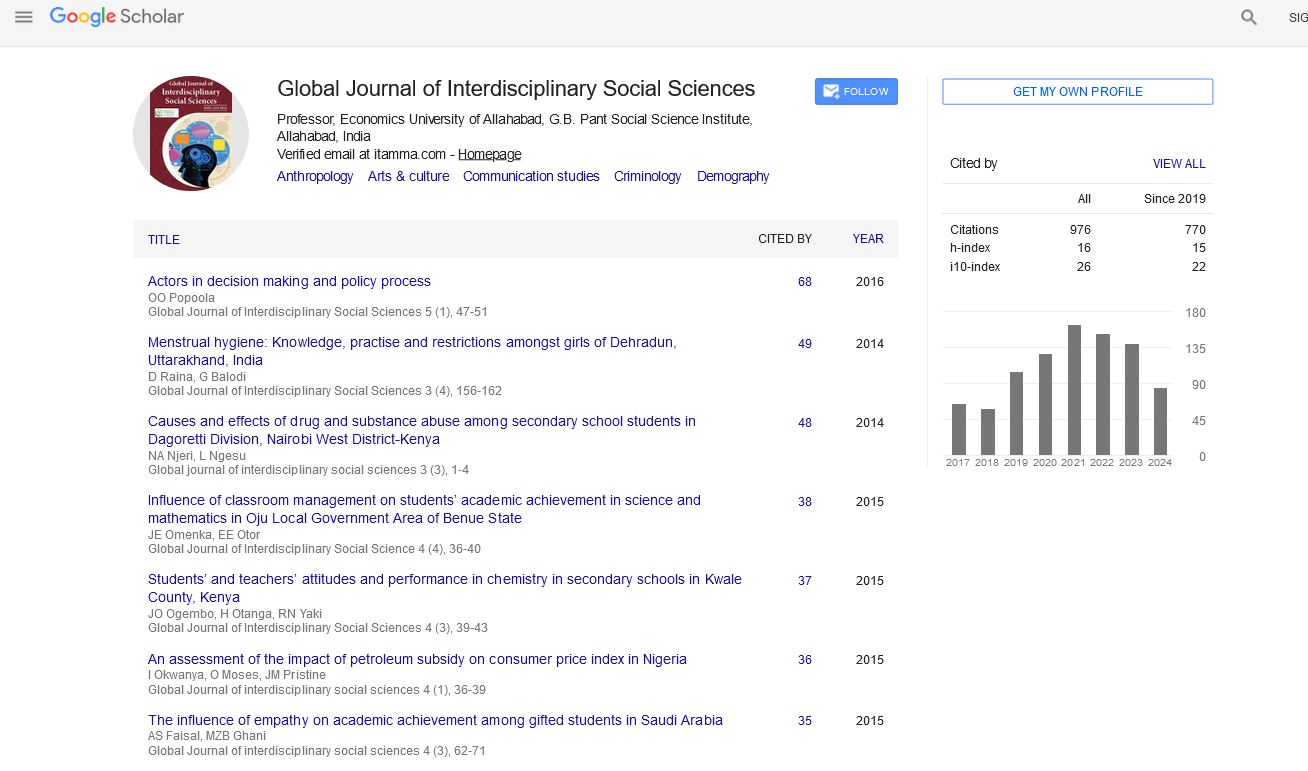Indexed In
- JournalTOCs
- Google Scholar
Useful Links
Share This Page
Journal Flyer

Open Access Journals
- Agri and Aquaculture
- Biochemistry
- Bioinformatics & Systems Biology
- Business & Management
- Chemistry
- Clinical Sciences
- Engineering
- Food & Nutrition
- General Science
- Genetics & Molecular Biology
- Immunology & Microbiology
- Medical Sciences
- Neuroscience & Psychology
- Nursing & Health Care
- Pharmaceutical Sciences
Short Communication - (2022) Volume 11, Issue 4
Climate Change Scenario in Himalayas
Rebecca Robins*Received: 04-Jul-2022, Manuscript No. GJISS-22-17845; Editor assigned: 07-Jul-2022, Pre QC No. GJISS-22-17845(PQ); Reviewed: 22-Jul-2022, QC No. GJISS-22-17845; Revised: 29-Jul-2022, Manuscript No. GJISS-22-17845(R); Published: 08-Aug-2022, DOI: 10.35248/2319-8834.22.11.029
Description
Climate is the long-term typically 30 years weather conditions (temperature, precipitation, humidity, wind speed, and direction) of a particular location. Climate change refers to any long-term deviation in climate parameters in response to natural and anthropogenic factors. Climate change is the most critical environmental challenge faced by humanity worldwide with serious implications on food and energy security, water resources, natural ecosystem dynamics and services, and human health, etc. Since the preindustrial era, considerable changes were observed in the earth’s climate system both at global and regional scales [1].
The warming observed during the last several decades of the 20th century is attributed to the increase in anthropogenic Green House Gas (GHG) concentrations. The Intergovernmental Panel on Climate Change (IPCC) has projected an increase of 1.4ºC-5.8ºC in the global temperature by 2100, which would have severe impacts on the global hydrological system, ecosystems, sea level, crop production, and related processes. The impact of climate change over the Himalaya is of particular concern as the region is sensitive to climate variability [2]. The Himalayan climate is mostly alpine but varies considerably with elevation from snow-capped mountains at higher elevations to tropical/subtropical climates at lower elevations, with varied vegetation types across the entire Himalayan arc. The Himalaya has an important role in governing global weather patterns. The Himalaya serves as a heat source in summer and heat sink in winter.
With the increased emission, the coupled cryosphere and hydrological process of the Himalaya are under stress from the warming temperatures [3]. The increasing temperatures result in more evaporation thereby increasing the moisture content in the atmosphere, causing changes in the present and future precipitation patterns, both spatially and temporally. Regimes can adversely affect the availability of water for human use and irrigation purposes, especially during the dry season. Over the Himalaya owing to its complex topography, climate change has induced localized weather events like cloudbursts, snowstorms, and high winds, etc. which pose a greater risk over the region.
Climate change is reported to have serious implications on Himalayan ecosystem services with negative impacts on mountain agriculture and agrobiodiversity. Besides, the climate change over the Himalaya has the potential to negatively affect the resilience to crop diseases as many crop species in the Himalaya are very sensitive to changes in temperatures induced by rising GHG concentrations. During the year 2013, northern India and western Nepal received monsoon precipitation much more than normal resulting in landslides and major floods in recent history. This intense rainfall has been attributed to anthropogenic climate change [4,5].
Conclusion
Despite the fragility and sensitivity of the Himalaya to the changing climate, robust and long-term climate change estimates are inadequate because of sparse and discontinuous observations. Further, robust and reliable projections of climate over the Himalaya are crucial for the local and regional scale impact assessments. The rate of warming over the himalayan region is considerably higher than the global average with much higher rates at higher compared to the lower altitude regions. The physical mechanisms driving the warming across the Himalaya are quite differential. The western Himalaya for example has 2 major rainy seasons, whereas a single rainfall season is prevalent over the central and eastern Himalaya. The observed and projected changes in the climatic variables are also varying across different regions of the Himalaya.
REFERENCES
- Hasson SU. Future water availability from Hindukush-Karakoram-Himalaya Upper Indus Basin under conflicting climate change scenarios. Climate. 2016;4(3):40.
[Crossref] [Google Scholar].
- Schickhoff U, Singh RB, Mal S. Climate change and dynamics of glaciers and vegetation in the Himalaya: an overview. Climate change, glacier response, and vegetation dynamics in the Himalaya. 2016:1-26.
[Crossref] [Google Scholar].
- Ranhotra PS, Shekhar M, Roy I, Bhattacharyya A. Holocene Climate and Glacial Extents in the Gangotri Valley, Garhwal Himalaya, India: A Review. Clim Change. 2022:125-142.
[Crossref] [Google Scholar].
- Dobhal DP, Pratap B. Variable response of glaciers to climate change in Uttarakhand Himalaya, India. InDynamics of Climate Change and Water Resources of Northwestern Himalaya. 2015;141-150. Springer.
[Crossref] [Google Scholar].
- Bhutiyani MR, Kale VS, Pawar NJ. Climate change and the precipitation variations in the northwestern Himalaya: 1866–2006. Int J Climatol. 2010;30(4):535-548.
[Crossref] [Google Scholar].
Citation: Robins R (2022) Climate Change Scenario in Himalayas. Global J Interdiscipl Soc Sci. 11:029.
Copyright: © 2022 Robins R. This is an open-access article distributed under the terms of the Creative Commons Attribution License, which permits unrestricted use, distribution, and reproduction in any medium, provided the original author and source are credited.

